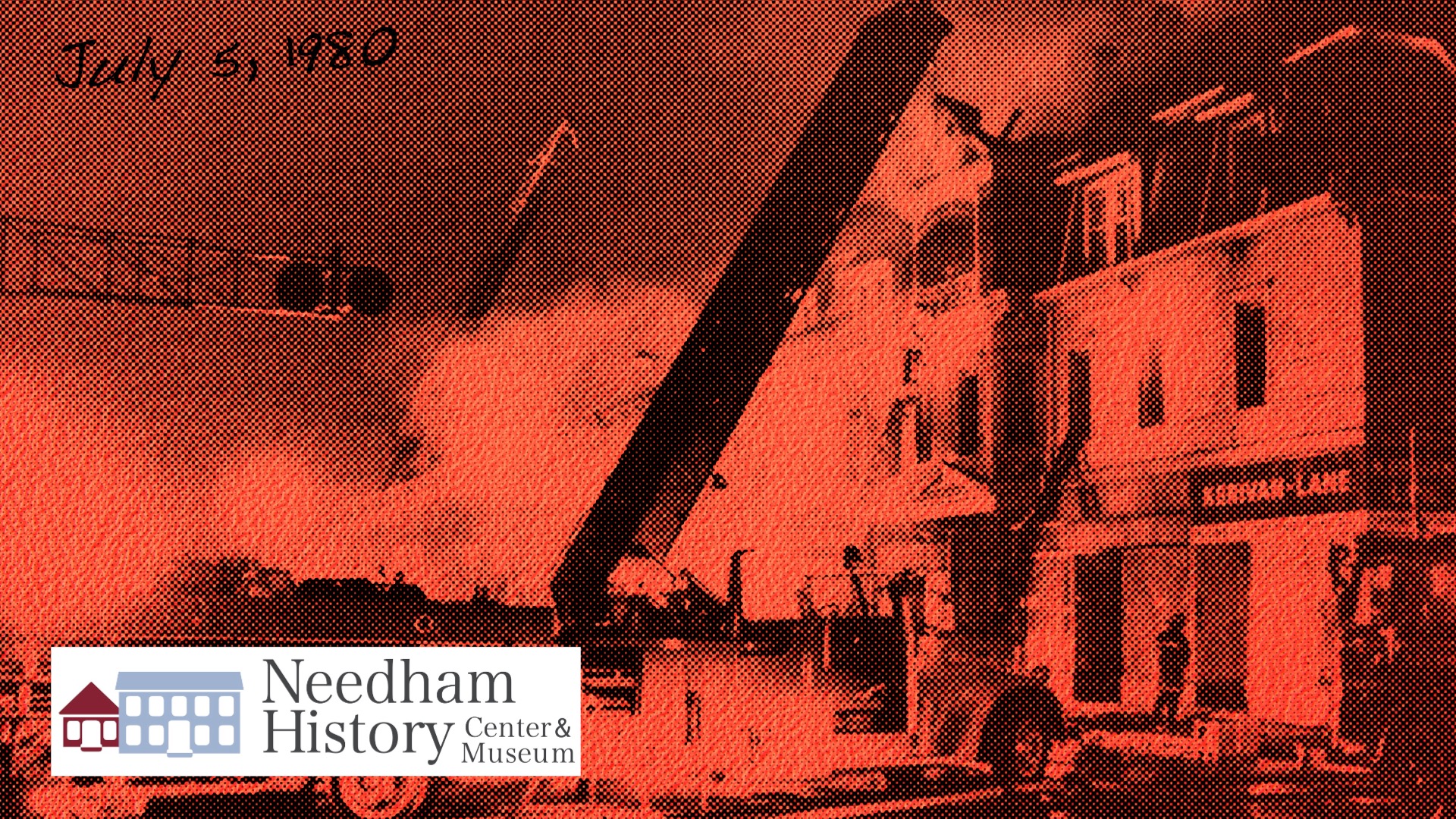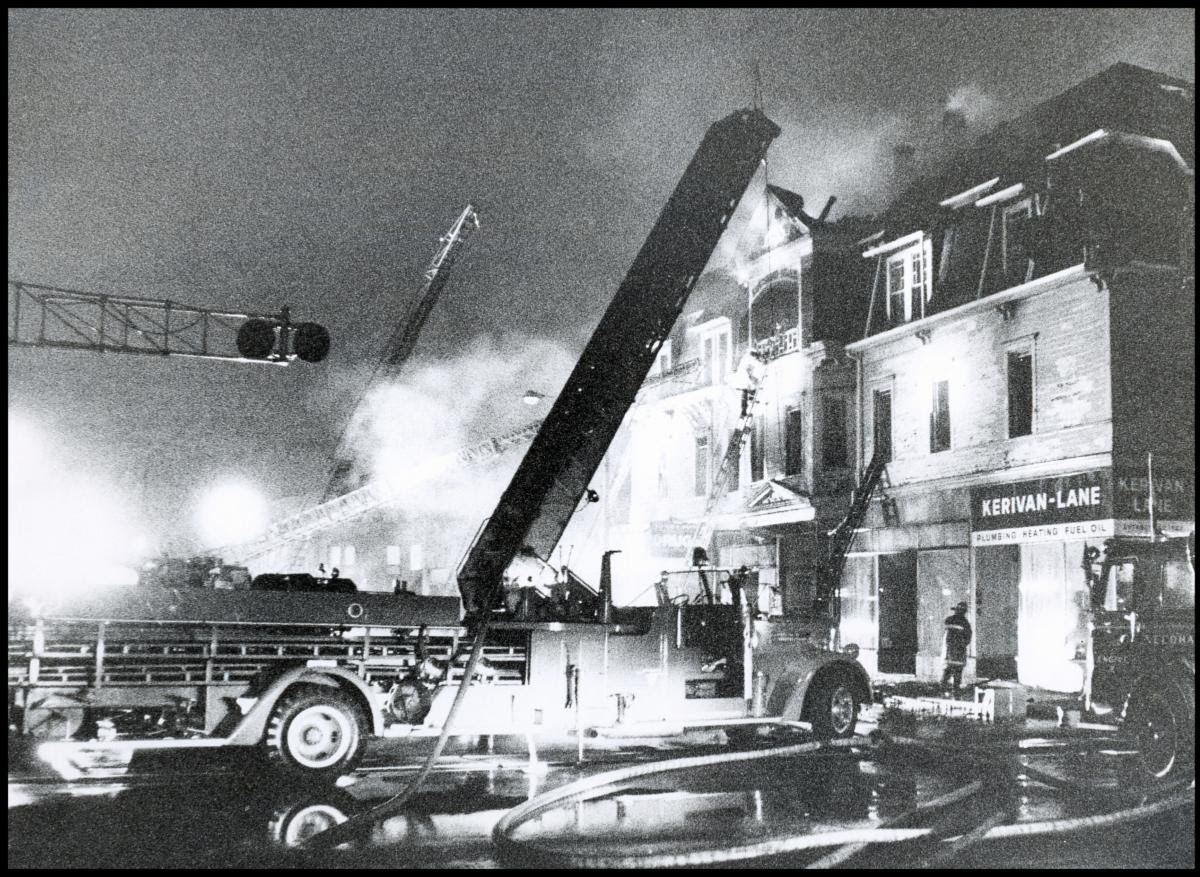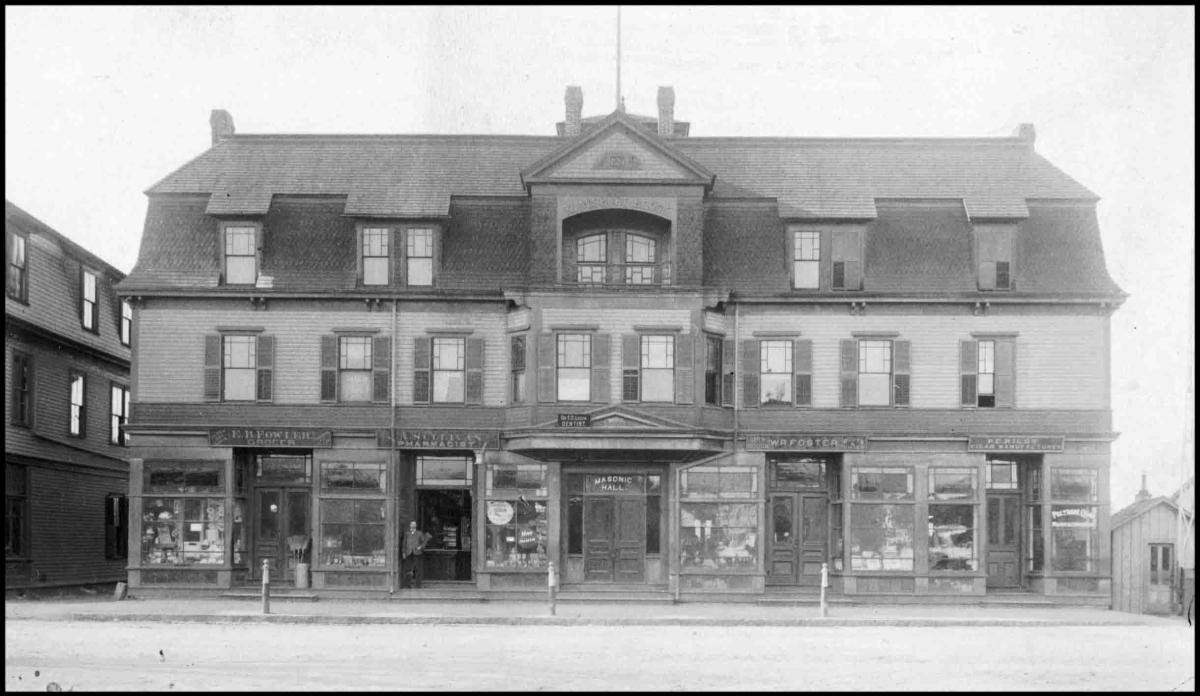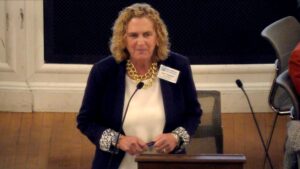
Needham History: The Kingsbury Block Fire
One of the last surviving structures from
the early development of the downtown.
 The four-alarm fire at the Kingsbury Building, during the night of July 5, 1980. The fire took ten hours to extinguish, and the Needham Fire Department was assisted by firefighters from 15 towns in the area.
The four-alarm fire at the Kingsbury Building, during the night of July 5, 1980. The fire took ten hours to extinguish, and the Needham Fire Department was assisted by firefighters from 15 towns in the area.
The Kingsbury Block Fire
On the night of July 5, 1980, the venerable Kingsbury Block burned down. The fire was discovered around 2:15 am, and rapidly escalated to four alarms as the flames raced through the old wooden structure. Through the night, more than 66 additional firefighters from 15 neighboring towns were brought in to help Needham’s own 48-man crew put out the blaze. Nine suffered injuries, but fortunately, none were life-threatening. The fire was finally brought under control about ten hours later. Investigation revealed that the probable cause of the fire was the careless disposal of cigarette ashes.
The Kingsbury Block stood at the location of the current three-story brick building at 1027-1037 Great Plain Avenue, on the east side of the railroad tracks. At the time it burned, it was both the oldest and the tallest building in the downtown. It had become shabby over the years, but still had a few tenants – The Curiosity Shop (“A Collection of Boutiques”), the Burgess-Warne Pharmacy, Gatto Real Estate, Kerivan-Lane Heating, and Stevens Fruit Store. After the fire, the building was deemed a total loss and was condemned by the town. It was not insured; Louis Stevens, who owned both the fruit store and the building itself, had let the insurance lapse a few years before because of the high cost of premiums. Nevertheless, the property consisted of a valuable three-quarters of an acre right in the downtown business district, so Stevens was able to sell and recoup his loss.
When it was built in 1887, the Kingsbury building was rather grand. It was built by Dr. Albert Dexter Kingsbury, a physician in town and former commander of the Galen Orr Post GAR, the Civil War veterans’ organization. Kingsbury owned several properties in town, as well as a fine Victorian home down the street near the Congregational Church (still standing – yay! – at 1175 GPA). He built the Kingsbury Block to replace the Odd Fellows Building, which had burned down a few months before. The first floor housed retail businesses, and the upper floors had meeting halls that were used for meetings by social and fraternal organizations, and for public functions. The Kingsbury Block joined the Moseley Block just as the Great Plain was growing as the new retail center of town. Side by side, the Mosley and Kingsbury Blocks extended along the south side of Great Plain Avenue between Chestnut Street and the railroad track as the town’s main business location.
The Kingsbury Block in its heyday, circa 1890. Ground-floor retail establishments include E.B. Fowler, grocer; A. Sullivan, pharmacist; W.R. Foster, dry goods; and P.E. Riley, cigar manufacturer. Dr. E.C. Leach, dentist; George Adams, hairdresser; and the Masonic Hall were upstairs. Foster, Fowler, Riley, Leach, and Adams had all relocated from the Odd Fellows Hall after that building burned down in 1887.
The 1980 fire was one of the largest fires in the town’s history, but it was not the only time that the Kingsbury Block burned. Fire seemed to haunt the building. The first fire occurred in 1893, when the building was only a few years old. It started in a shed and spread to the main structure, causing extensive damage. Ironically, several of Kingsbury’s tenants in the new building had recently relocated from their premises lost in the Odd Fellows Fire. The fire threatened but did not spread to the Moseley Block next door, though grocery store owner Thomas Sutton feared it would damage his stock. “Thomas Sutton thought at one time that his meat would be roasted,” reported the Needham Chronicle. “It wasn’t, but it is in a nice condition to roast.” Har har.
There was another fire in 1910, which was extinguished before it could spread beyond the third floor where it started. However, although the fire was not large, there was extensive water damage on all floors from the attempt to put it out. This time the Chronicle took a more serious tone: “The probable outcome of a fire in this block has long been a source of dread to all, and the fact that Wednesday’s fire was extinguished with no greater loss is a credit to the town’s [fire] department.” Another fire followed in 1920, though apparently with little damage.
Given its early fire history, it is fortunate and perhaps surprising that the Kingsbury Block lasted as long as it did. The big open wooden pile was balloon-framed, without any barriers in the walls to prevent fire from traveling up the frame. This was a common construction method in those days, though it would not be allowed now. The Kingsbury was also built at a time when public buildings were grander – a source of civic pride and identity. Even a functional retail block had details and flourishes that were meant to show off the town’s prosperity. In the years since, building codes have evolved to limit risk, and the economics of building often discourage decorative detail. So, the square brick block on the site now, also called the Kingsbury Building, is certainly safer and more efficient. But it is not nearly as grand.
The Kingsbury Block, seen from corner of Chapel Street and Great Plain Avenue, circa 1970. By this time, the building was the oldest and tallest building in the downtown – one of the last surviving structures from the development of the Great Plain as the town center.
 |
Gloria Polizzotti Greis is the Executive Director of the Needham History Center & Museum. For more information, please see their website at www.needhamhistory.org. |

